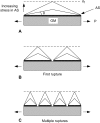Traversing the intact/fibrillated joint surface: a biomechanical interpretation
- PMID: 15679871
- PMCID: PMC1571455
- DOI: 10.1111/j.0021-8782.2005.00371.x
Traversing the intact/fibrillated joint surface: a biomechanical interpretation
Abstract
Cartilage taken from the osteoarthritic bovine patellae was used to investigate the progression of change in the collagenous architecture associated with the development of fibrillated lesions. Differential interference contrast optical microscopy using fully hydrated radial sections revealed a continuity in the alteration of the fibrillar architecture in the general matrix consistent with the progressive destructuring of a native radial arrangement of fibrils repeatedly interconnected in the transverse direction via a non-entwinement-based linking mechanism. This destructuring is shown to occur in the still intact regions adjacent to the disrupted lesion thus rendering them more vulnerable to radial rupture. Two contrasting modes of surface rupture were observed and these are explained in terms of the absence or presence of a skewed structural weakening of the intermediate zone. A mechanism of surface rupture initiation based on simple bi-layer theory is proposed to account for the intensification of surface ruptures observed in the intact regions on advancing towards the fibrillation front. Focusing specifically on the primary collagen architecture in the cartilage matrix, this study proposes a pathway of change from intact to overt disruption within a unified structural framework.
Figures










References
-
- Bank RA, Soudry M, Maroudas A, Mizrahi J, Tekoppele JM. The increased swelling and instantaneous deformation of osteoarthritic cartilage is highly correlated with collagen degradation. Arthritis Rheumatism. 2000;43:2202–2210. - PubMed
-
- Bartels JE. Femoral–tibial osteoarthrosis in the bull: 1. Clinical survey and radiological interpretation. J. Am. Vet. Radiol. Soc. 1975;16:151–158.
-
- Broom ND. The altered biomechanical state of human femoral head osteoarthritic articular cartilage. Arthritis Rheumatism. 1984b;27:1028–1039. - PubMed
-
- Broom ND. The collagenous architecture of articular cartilage – a synthesis of ultrastructure and mechanical function. J. Rheumatol. 1986a;13:142–152. - PubMed
Publication types
MeSH terms
LinkOut - more resources
Full Text Sources
Medical

